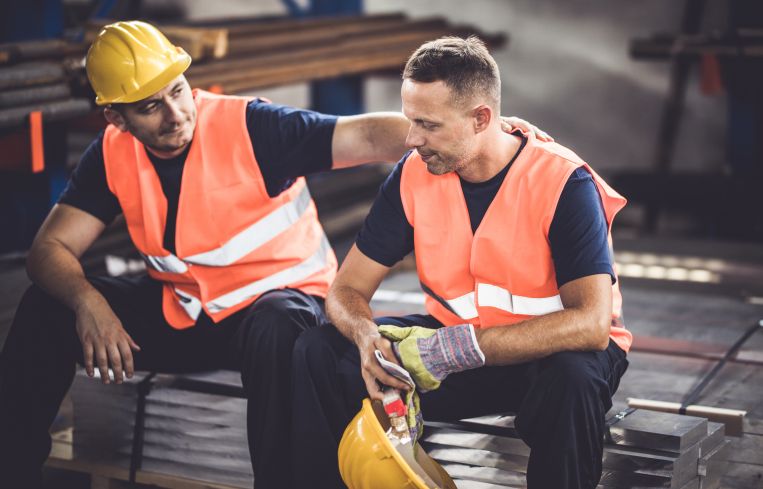New York Efforts Aim to Curb Suicides in the Construction Industry
New laws, training and counseling target the cause of thousands of deaths in the industry each year
By Isabelle Durso September 3, 2025 5:11 pm
reprints
More than 5,000 construction workers in the U.S. killed themselves in 2023.
While construction workers have always faced dangers — 982 workers died from construction-related work injuries last year, according to data from the Center for Construction Research and Training (CPWR) — the worst, it turns out, are psychological, leaving construction second only to mining in the number of workers who take their own lives.
In response, New York City officials, labor unions and the private sector are stepping up efforts to stem the tide.
The number of suicides among construction workers in the U.S. has remained roughly the same over the past few years, and the suicide rate among male construction workers is 75 percent higher than for men in the general population, according to the Centers for Disease Control and Prevention (CDC).
This is largely because construction work-related issues such as chronic pain and sleep deprivation can lead to higher levels of stress, anxiety, depression and drug misuse, the CDC found.
“Construction is a very demanding occupation,” Shaun Carvalho, chief safety officer at Shawmut Design and Construction, told Commercial Observer. “Everybody wants things built yesterday. So there’s always this pressure to get the job done fast. That results in long days, and oftentimes we’ve got big commutes to get to the job sites, so we’re away from home for long periods of time.”
In addition to suicides, intense stress levels also lead to increases in workplace injuries and drug overdoses, according to NBC News.
New York City saw 69 fatal work injuries in 2023, with 24 of those deaths occurring in the construction sector, according to a February report from the U.S. Bureau of Labor Statistics. Half of those fatalities were due to falls, slips and trips.
There has been a slight drop in construction work-related injuries or fatalities in the city this year, with 199 incidents recorded so far in 2025 compared to the 311 incidents already recorded at this time last year, according to the New York City Department of Buildings.
“Through our persistent efforts, construction injuries reached a nine-year low in 2024, and a 10-year low in fatalities,” a City Hall spokesperson said in a statement to CO. “This has continued into this year.”
But those numbers pale in comparison to the 15,900 overdose deaths among construction workers in 2023, with synthetic opioids involved in three out of four of those deaths, according to CPWR.
Overall, construction workers are six times more likely to die from suicide than from job site-related injuries, the CDC found.
“[Construction work is] physically demanding, can lead to chronic pain, and [there’s] stress of [uncertain] employment once the project’s over,” Carvalho said. “All that mental stress can result in some unfavorable numbers around pain management, using opioids to help offset that.”
The Boston-based Shawmut launched an opioid task force in 2018 to provide its 1,500 employees — and its roughly 50,000 to 60,000 additional yearly employees through subcontractors — with training on how to use overdose medication Narcan on a job site, Carvalho said. Narcan nasal spray can reverse the effects of an opioid overdose in as little as two minutes, according to the CDC.
In New York City specifically, at least 269 construction workers died of an overdose in 2020, according to the DOB.
“By educating construction workers on substance use disorders and providing them with the support they need, we are addressing this dire issue and helping the New Yorkers who build and maintain our city,” New York Mayor Eric Adams said in a 2023 statement.
New York is taking steps to raise awareness on the issue, as the city’s fiscal year 2026 budget includes $1.1 million for construction site safety training, $3.97 million for the expansion and development of day laborer centers, and $600,000 to support programs for low-wage immigrant women workers, according to a source.
The Building Trades Employers’ Association (BTEA), which works with various building trade unions in New York, is also acting to educate its members on mental health awareness and overdose risk, especially with September marking National Suicide Prevention Month.
BTEA, in partnership with organizations including the Real Estate Board of New York, the New York Building and Construction Trades Council and the New York Building Congress, will provide its members with in-person construction site safety training, as well as instructions on how to use Narcan to prevent opioid overdoses.
“Mental health and suicide are uncomfortable topics for many people, especially for our members and people who work in the construction industry,” said Elizabeth Crowley, president and CEO of BTEA. “We want to raise awareness, because we need to do more to save lives. It’s truly a silent killer.”
Opioid use isn’t the only substance abuse problem facing construction workers, as roughly 12 percent of people in the construction industry identify as having an alcohol use disorder, compared to about 7 percent in the general population, Carvalho said.
“When you’re not working [on your project], are you sticking to your routine of coming home and going to your kids’ game, or trying to fill that void with something else because you’re away from home?” Carvalho said. “There’s a lot of different ways you can go. Many people hit the gym. Many might hit a bar.”
Most of the stress among construction workers also seems to come from working on larger, more complicated projects such as data center developments.
Data center projects in the U.S. are bigger — and more demanding — than ever, with the number of data centers in the U.S. reaching 5,426 as of March 2025. But those data center projects, supported by billions in federal funding, are driving a significant imbalance when it comes to construction resources in other sectors.
Not only are data centers taking resources away from other construction sectors, such as housing, but they’re also putting an increasing strain on the construction workforce. Workers are facing longer workdays, stricter deadlines, and more time away from home due to the remote location and sheer size of these projects, NBC News reported.
“Time away from home, time away from your family, your core, where you feel safe and secure, that’s such a human need, and you’re now removed from that,” Carvalho said.
Shawmut is taking steps to speak to its workers — especially its male construction workers — on a more “human” level about these issues, as men are far less likely to seek mental health help than women, according to Carvalho.
“It does seem like we’re still in a world where many people, certainly men, feel like they need to hide their emotions, not talk about things, and just get the job done,” Carvalho said. “So to say, ‘Rub some dirt on it, hide your feelings and keep marching,’ is not OK anymore.”
In New York City, officials are ready to help.
Councilmember Carmen De La Rosa of Manhattan recently introduced two pieces of construction-related legislation: the Construction Justice Act and the Worker Fatality Act.
The Construction Justice Act, or Introduction 910, calls for developers of housing projects that receive financial assistance from the city to pay their workers a minimum combined wage and essential benefits package of at least $40 per hour, with no less than $25 of that package being wages. In addition, the bill would require those developers to ensure that at least 30 percent of the hours worked on the project were by residents of a ZIP code where at least 15 percent of the population is below the poverty line.
The Worker Fatality Act, or Introduction 685, would require the commissioner of the New York City Department of Consumer and Worker Protection to maintain an online, publicly available database of information about workplace fatalities that occur in the city.
Both bills are still moving through the legislative process, but a spokesperson for Councilmember De La Rosa said the team is hoping to pass both laws before the end of this year.
Isabelle Durso can be reached at idurso@commercialobserver.com.


